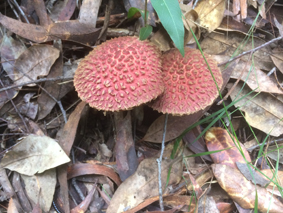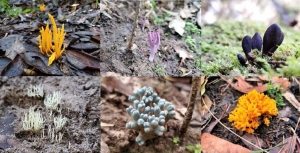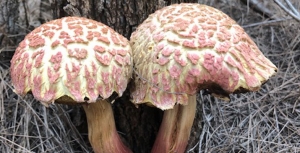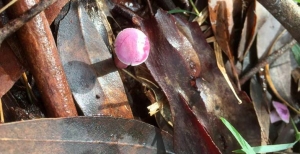Displaying items by tag: fungi
Book review: Underground Lovers: Encounters with Fungi
Prepare to appreciate the world under your feet (well, your feet grounded on the earth, maybe not on a concrete slab).
There is a network of mycelia that belong to their own kingdom: Fungus. Lacking chlorophyll, they grow from the tips of microscopic hyphae and digest nutrients externally (underground) before absorbing them into the mycelium.
One hypha is a microscopic filament but together they form a fungus mycelium (the network). Hyphae can not only branch but also fuse, or ‘anastomose’ and exchange genetic material. The cell walls are made of chitin, a hardness also found in arthropod exoskeletons. The mycelial scaffold essentially mirrors exponentially the life forms above ground. Mycelial networks bind soil particles while also aerating the soil, creating spaces in the soil. This architecture allows water to penetrate soil’s deepest horizons.
The fungi also form alliances with plants, or even digest other organisms. Fungi and algae, forming lichens, create soil on rock – as on exposed rock left by the retreating Vatnajökull ice cap in Iceland.
Many plants depend on mycorrhizal fungi – the fungi forming beneficial relations with roots: hyphae extend the roots’ absorbable surface; the tree provides sugars from photosynthesis while the mycorrhizal fungi make nitrogen and phosphorus available to the tree.
The author gives us good reason not to clear-fell, nor burn our forests in super-hot conflagrations, nor overheat the earth with global warming, nor over-fertilise and apply weedicides to our monocrops; even the high-velocity gale of the leaf-blower dislodges spores, let alone grasshoppers, beetles and frogs. It kills the fungi.
Some ‘old growth’ trees reach hundreds of years of age; but the fungi beneath them are at least as long-lived. Old forests support a greater diversity of fungi than young, or obliterated, forests.
Interesting allusions – Pouliot mentions her US Northwest rented V8 Dodge Charger not being the ideal field vehicle ‘with the clearance of an echidna’.
The ninth chapter Women as Keepers of Fungal Lure fills a gap. I searched for books on fungi and nearly all the citations are of men’s studies.
The tenth chapter Restoring Fungi is apposite given the fungus talks by Emeritus Prof Michael Gillings and Vanessa McPherson of Macquarie University. They observed that sites where works such as a drainage pipe had been laid hosted far fewer fungi than undisturbed (or merely weeded) sites. A property owner demonstrates that we need to create diversity and reduce stresses. On her property she supplied diverse organic matter of different species, size and age, and eliminated tilling, digging, excavating, heavy machinery and even hard hooves of stock.
Mistletoe contributes to restoration, providing nectar for butterflies, gliders and possums; and when it dies its leaves enrich the soil with phosphorus, nitrogen and potassium.
Lichens colonise bare earth and are part of the cryptogamic crusts essential for forming a film that reduces wind and water erosion. This crust of fungi, algae, cyanobacteria and mosses over the soil fixes carbon and nitrogen – and is destroyed by stock. The property owner, Kazuko, observes ‘We should be starting with soil crusts rather than trees when restoring ecosystems’.
Fungi have infiltrated Landcare! Officially restoring waterways, agricultural and natural areas since 1989, the movement now recognises the necessity of healthy fungi.
The author has travelled the globe and gives examples of mycophiles’ world-wide fungus hunting throughout the book. There is a species register with common and scientific names of fungi and lichens, plants and animals; a glossary, selected sources and an index. The editor might have picked up the constant misuse of ‘among’ and ‘between’. Despite the listing of 11 images, there are no photographs. Our desire for pictures and descriptions of so many intriguing species and descriptions probably needs a mini-encyclopaedia!
Alison Pouliot, NewSouth Publishing, 2023; 278pp (reviewed by Margery Street)
Fungi of the Lane Cove Valley: diversity, distribution and DNA
Fungi are poorly known. Of the estimated 3 to 8 million species in existence, only about 120,000 species ever have been named and described. This accounts for only 2 to 5% of the estimated total.
The Australian biota is unique, with many of our plants and animals being found nowhere else. It is very likely that Australian fungi are also unique. However, Australian fungi are often assigned names of Northern Hemisphere species that look similar. This means that Australian fungi may be even more poorly known.
There are a number of reasons that fungi are under-described. First, fungi spend most of their lives existing as mycelial networks, hidden underground. Second, when we do see fungi, they are the reproductive fruiting bodies (mushrooms, toadstools etc). These are mostly small and ephemeral. And, these fruiting bodies often do not have many consistent, distinguishing characteristics.
Despite our lack of knowledge of fungal diversity, we do know that they perform essential roles in ecosystems. They have diverse roles, including as pathogens (causing disease to plants or animals), saprotrophs (breaking down dead animal and plant material) and mutualists (supporting the growth of plants). Almost all land plants form beneficial associations with fungi, as mycorrhizae (fungus root), so conservation of plant communities must also include conservation of their fungal partners.
There are two ways to approach fungal identification. Traditionally, people have used culturing of fungi and surveys of above-ground fruiting bodies. More recently, DNA-based methods have been used to directly survey fungal species in soil. However, a compromise approach combines field surveys with DNA-barcoding. This allows us to identify fungal fruiting bodies, initially to the genus level, and potentially the species level if the species has previously been formally described and then characterised using DNA. We have used this combination approach to identify club and coral fungi in the Lane Cove Valley.
We chose to investigate the club and coral fungi because they exhibit all the characteristics that contribute to fungi being poorly described. The fruiting bodies are small and have few distinguishing characteristics. They are often cryptic, and from our initial observations, seemed to include a range of undescribed species.
To plan our field work, we used John Martyn’s STEP maps to identify track segments of 1 to 2 km which we could survey in a single trip (fungal surveys move very slowly!). Over 2020–22, we have walked every track on the STEP maps multiple times during our fungal explorations of the Lane Cove Valley. We collected some thousands of specimens under our scientific permit issued by the Department of Planning, Industries and Environment. We are now in the process of extracting DNA to sequence and characterise local species.
Our study is far from complete, but we can already report some general observations. Many species in the Lane Cove Valley are undescribed, with up to 30 to 40% of specimens being new species. Club and coral fungi are not distributed evenly through the valley. These types of fungi are mainly found along creek lines, particularly those dominated by coachwood. Our observations suggest that the sides of creeks where sewer lines have been laid host lower fungal diversity and abundance than their corresponding sewer-free creek-sides. Creeks with no sewer lines are often rich in fungal species.
We have also noticed that areas dominated by weedy vegetation have different fungal communities. These areas have generally depauperate communities, with fewer fungal species and fewer fruiting bodies. When areas of weedy bushland are regenerated, this does not appear to be accompanied by recovery of the fungal diversity that is found in more pristine areas. We can often identify regenerated areas through their altered fungal species types and abundance, and refer to the fungi in these areas as fungal ‘weeds’.
In less disturbed areas of bushland, we have documented significant fungal hotspots. In these areas, there is elevated fungal diversity and abundance. There are three outstanding locations for fungal diversity in the Upper Lane Cove Valley. These are Rofe Park/Sheldon Forest, Browns Field, and Coups Creek. All these areas are sheltered valleys that face southwest, and all are likely to be nutrient rich. We think that these locations contain important remnant populations of native fungi that are worthy of conservation, similar to Lane Cove Bushland Park, a reserve dedicated to the conservation of endangered waxcap fungi. Notably, these areas are not within the boundaries of the national park.
Although our results are still preliminary, we can already see some potential implications for conservation and environmental protection. If bush regeneration schemes are not accompanied by natural fungal regeneration, we might need to use inoculum from known fungal hotspots to reintroduce the fungi that are missing from regenerated areas. Reintroduction of native fungi into these plant communities should improve their stability and resilience. Understanding the role of soil fungal diversity in regeneration and restoration of natural bushland areas could be key to the long-term success of conservation and preservation efforts.
Finally, there are clearly many new species of fungi in our region. The formal process of naming these will take many years, but is important for understanding and monitoring fungal ecology. During our surveys, there are some fungi that we have only ever seen once or twice. Since we have also seen multiple examples of extremely rare species of plants and animals during these trips, we think that these fungi are also rare and possibly endangered. There is certainly much more to be done to understand the fungi and their roles in ecosystems.
References and further reading
D.L. Hawksworth and R. Lücking (2017) Fungal diversity revisited: 2.2 to 3.8 million species. Microbiology Spectrum 5(4)
R. Kearney and E. Kearney (2015) Conservation of fungi in Lane Cove Bushland Park. Australian Network for Plant Conservation 24
On 28 June 2022 Vanessa McPherson and Prof Michael Gillings gave STEP a fascinating talk about fungi and their important contribution to ecosystem. They have kindy provided a summary of the talk. They work with the School of Natural Sciences, Macquarie University. (This email address is being protected from spambots. You need JavaScript enabled to view it.; This email address is being protected from spambots. You need JavaScript enabled to view it.)
Great Season for Fungi
Our walk in Fox Valley on 14 April revealed some surprises. A Powerful Owl was spotted and there were several unusual examples of fungi as identified by John Martyn.

Calocera or Dead Man’s fingers

Bolettus emodensis
Rare Fungi
John Martyn discovered this beautiful pink fungus in Sheldon Forest.
Fungi expert Ray Kearney identified it as Cantharellus lilacinus. A wet weather rarity.















